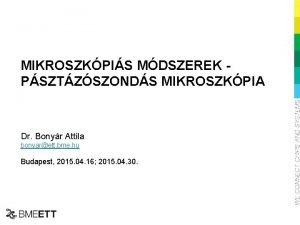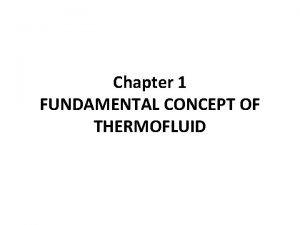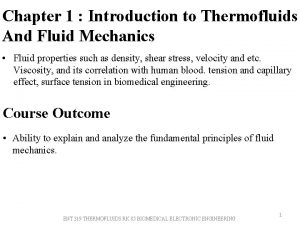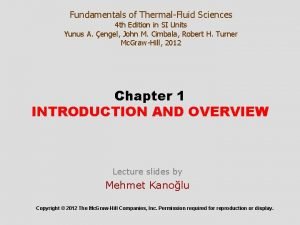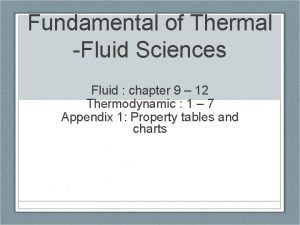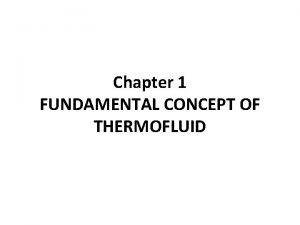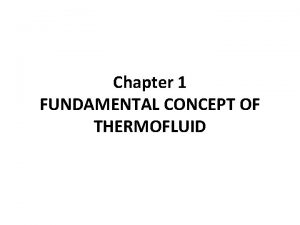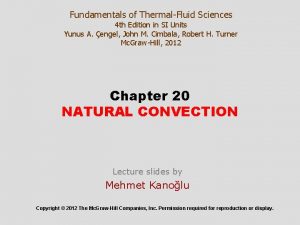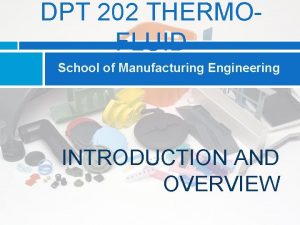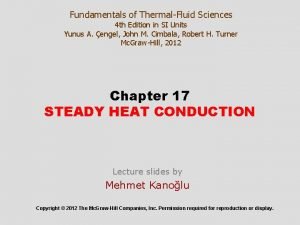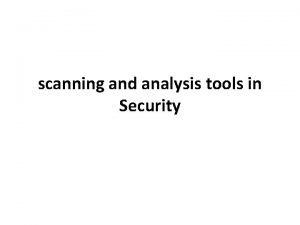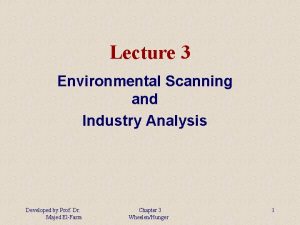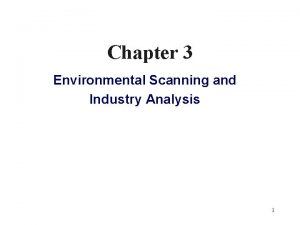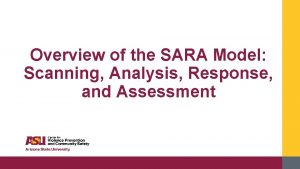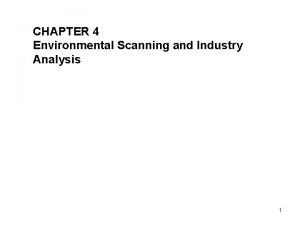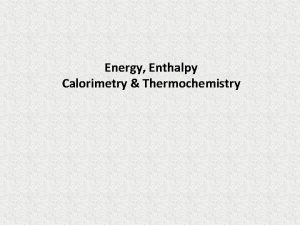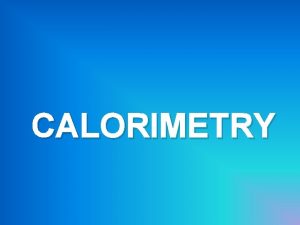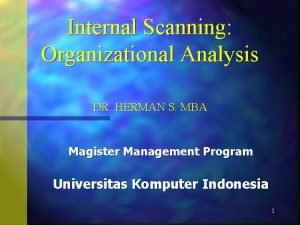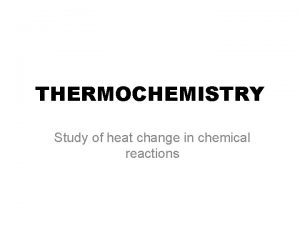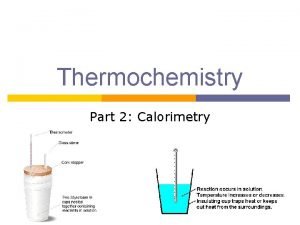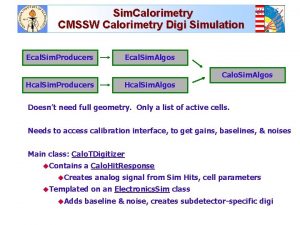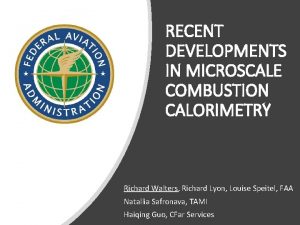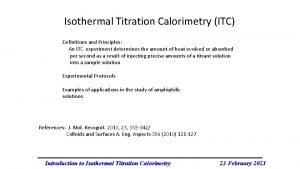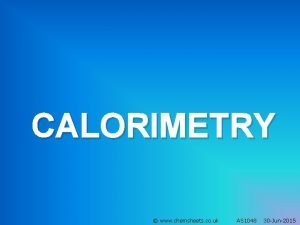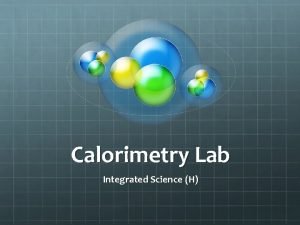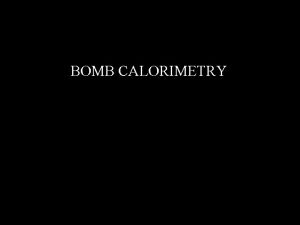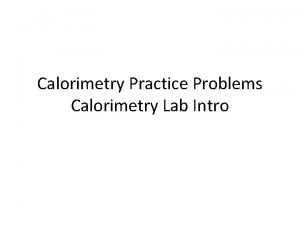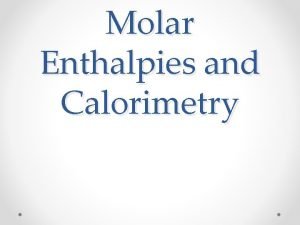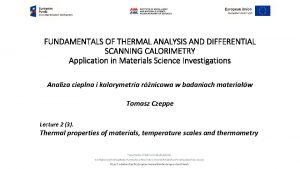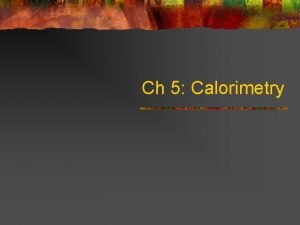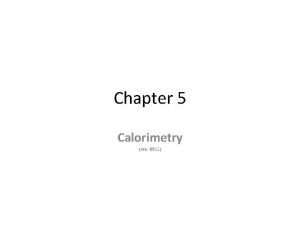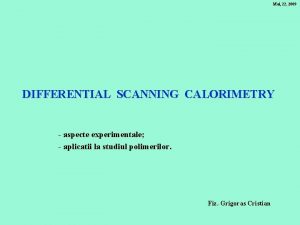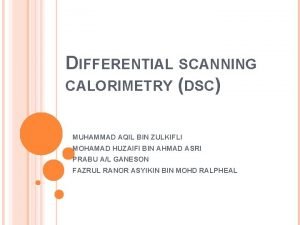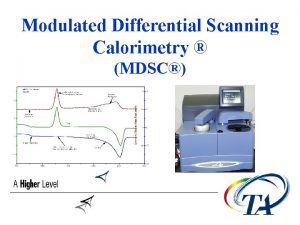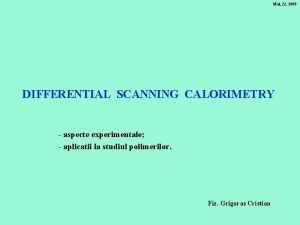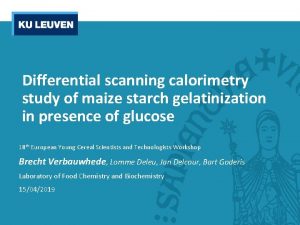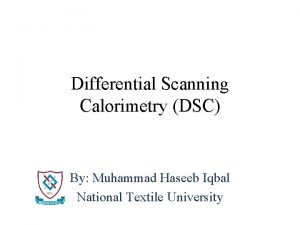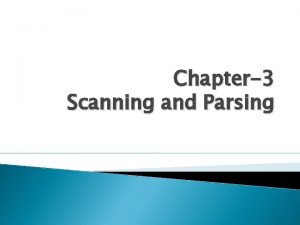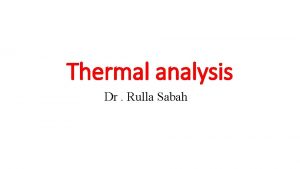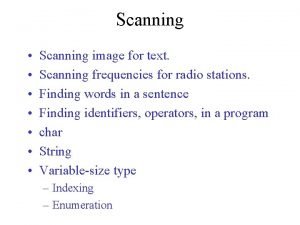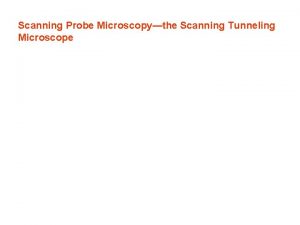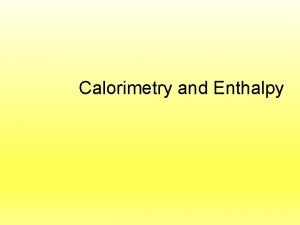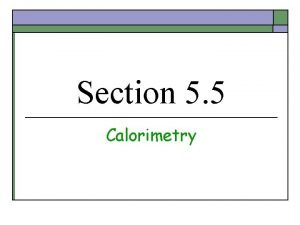FUNDAMENTALS OF THERMAL ANALYSIS AND DIFFERENTIAL SCANNING CALORIMETRY



































- Slides: 35

FUNDAMENTALS OF THERMAL ANALYSIS AND DIFFERENTIAL SCANNING CALORIMETRY Application in Materials Science Investigations Analiza cieplna i kalorymetria różnicowa w badaniach materiałów Tomasz Czeppe Lecture 4 (5). Thermal analysis- basic classifications, differential thermal analysis and thremogravimetric thermal analysis

Outline of the methods of thermal analysis -1 METHOD ABR. RANGE (o. C) MEASURED PROPERTY APPLICATION Differential Thermal Analysis DTA 100 –- 2000 temperature difference tempertures of phase transformation or chemical reaction Differential Scanning Calorimetry high-temperature (calibrated DTA) DSC (DTA) 100 –- 1700 heat flux tempertures of phase transformation or chemical reaction, transformation enthalpy, heat capacity Differential Scanning Calorimetry DSC -170 –- 600; 710; 1000; heat flux heat capacity, temperatures end enthalpy of phase transformation, chemical reactions Differential Scanning Calorimetry DSC -170 –- 600; 710 power compensation heat capacity, temperatures end enthalpy of phase transformation, chemical reactions Pressure Differential Scanning Calorimetry PDSC -170 –- 600; 710 heat flux under increased hydrostatic pressure heat capacity, temperatures end enthalpy of phase transformation, chemical reactions under pressure Modulated Differential Scanning Calorimetry TMDSC -170 –- 600; 710 heat flux under modulated amplitudę and frequency of heat tranfer reversibiity of the phase transformations, reversible heat capacity, temperatures end enthalpy of phase transformation, chemical reactions,

Outline of the methods of thermal analysis -2 METHOD ABR. RANGE (o. C) MEASURED PROPERTY APPLICATION Ultra – high rate DSC (Mettler Toledo) Flash DSC-1 30 -500; -95 -420; rates: cooling 6 -240. 103, heating 30 - 2, 4. 106 K/min power compensation Peltier cell phase transformations, temperatures and enthalpies in extremely high rats of temperature changes Isothermal titration calorimetry Nano-ITC 2 –- 80 K power compensation Peltier cell biopolymers, enzymes and others. ; thermodynamics of molecules, molecular bonding interactions Nano- Differential Scanning Calorimetry Micro- DSC Nano. DSC MC DSC -10 –- 130 or 160; -40 – 150; power compensation Peltier cell heat capacity protein, makromolecules in solutions, pharmaceutics, thermal stability, bonds, pressure influence; Thermogravimetry TGA TP –- 1500 ; 1600 mass change processes with mass change, oxidation , decomposition synthesis; Thermogravimetry + DTA SDT 100 –- 1600; 1700 Mass change, temperature difference, heat flux calibrated processes with mass change and heat effects, oxidation , decomposition synthesis;

Outline of the methods of thermal analysis -3 METHOD ABR. RANGE (o. C) MEASURED PROPERTY APPLICATION changes of mass in a result of sorption of water vapor or other organic liquids; aadsorption, desorption of water, isotherms of adsorption, processes and phase composition of pharmaceutics, amount of the crystalline phase, kinetics of draying Sorption analysis (+ Raman spectroscopy) Thermogravimetric sorption analysis VTI - SA 5 - 150 GVS 5 –- 85 Dilatometry DL 25 – 2000 0, 1 – 50 K/min thermal expansion, changes of density with temperaturę; phase transformations, sintering, oxidation, ceramics, super-hard materials, high temperature alloys and ceramics; Thermomechanical analysis TMA DTMA thermal expansion or contraction under loads of different character, softening, thermal volume change; thermal expansion coefficients, deformability in temperature, phase transformations, dumping capacity, brittleness, softening temperatures Dynamothermomechanical analysis -150 - 1550 0, 01 - 50 K/min 0, 001 – 3 N 0, 01 -1 Hz Dynamo- mechanical analysis DMA -170 - 600 0, 01 -100 Hz 16 N elastic reaction under high frequency loads of different character; elastic modulus, coefficient of vibrations dumping, stiffness coefficient, phase transformations, deformability, composition;

Outline of the methods of thermal analysis -4 METHOD ABR. RANGE (o. C) MEASURED PROPERTY Solution calorimetry enthalpy of mixing Drop calorimetry Enthalpy of mixing APPLICATION Heat conductivity DTC thickness to 32 mm /0, 1 mm Stationary heat conductivity l = (Q/A)/(DT/L) heat conductivity coefficient l at room temperature for the solid and liquid samples and thin coatings; Heat diffusivity (laser or xenon lamp) DLF LFA -150 – 2800 thickness from 6 mm pulse heat diffusion coefficients a, l and Cp in function of temperature for solid and liquid phases and coatings; a = l/r. Cp

Classical differential thermal analysis and high temperature DSC – types and construction „improved DTA” „classical DTA” Tp Ts T 0 signal d. T = Tp-Ts „temperature gradient DTA” Tp Ts DQ T 0 „high temperature DSC” „DTA with no temperature gradient” d. T = Tp-Ts ~ d. Q signal d. Q/d. T ~ Tp-Ts

Classical differential thermal analysis and high temperature DSC – operation 1. The DTA in classical construction do not offer any way of the heat transfer except gas convection and radiation in high temperatures. The signal supplies the differential d(Tp-Ts)/dt while T=T 0 + (d. T/dt)dt = Q = programmed current temperature. The unit for the signal is [DTo. C. s/mg]. 2. DTA Supplies similar results like precise differential temperature (DT) measurements but in relations to the standard preferably of the similar mass. This compensation in heat capacity supports the shape of the base line. 3. The lack of the controlled heat flux density (look our previous lecture about heat conductivity) causes thermal gradients in the sample, so the important requirement is very small mass of both sample and standard. 4. The next problem generated by the system is a sensitivity for the relative position of the sample and standard versus respectful thermal elements, and a geometry of the active elements of the system, hard to preserved in the sequence of measurements.

Classical differential thermal analysis construction Liners and cups Screws regulating furnace linearity „classical DTA” „temperature gradient DTA” Gas temperature equilibration A small masses are important to avoid temperature gradients.

Classical differential thermal analysis signals /base line § It should be remembered that the signal measurements are in two axis; time and temperature. The results in the time function are not useful in many cases so they are presented in function of temperature. The unit for the signal is [DTo. C. s/mg]. § The DTA supplies signals T=f(t) and DT=f(t) similar to differential temperature (DT) measurements but in relations to the standard (look the left figure, a blue and brown lines). This compensation in heat capacity supports the shape of the base line, which in a best case may be like in the right figure. Non monotonous base line may cause serious problems.

Classical differential thermal analysis advantages and disadvantages 1. The very high precision of the temperature measurement is decreased by the external factors like temperature lost by convection and radiation at high temperatures, lack of symmetry between thermoelements and the furnace and the not perfect thermal contact between samples and thermoelements. 2. The advantage of the system of DTA is simplicity, direct measurement of the primary factor that is temperature, what gives commonly a sharp jumps on the resulting signals (*). 3. The other important advantage is less of the expensive elements in construction which may be destroyed at high temperatures e. g. by evaporation (Pt). 4. This type of DTA remains good equipment for solving problems in thermal analysis in the case if we want to determine the critical temperatures or temperature range of the processes but not the amount of the heat flux or heat capacity of the material.

Classical differential thermal analysis and high temperature DSC – types and construction 1. DTA as all the TA methods bases on the temperature scale. This makes the standardisation of temperature crucial for the true results. For this type of method the calibration is most simple, concerns only temperature. 2. It should be remembered that very important role play also external elements and conditions used in experiments, like type of caps and covers, type of gas for purification, the flux of the gas and possibly other factors. 3. Typical cups for the DTA of this type are somehow different in the form from the others: some of them is shown in next slides. 4. The classical DTA or modification of high temperature DSC to it may be advised for very high temperature experiments, that is above 1000 o. C.

Classical differential thermal analysis and high temperature DSC – types and construction q. The calibration procedure includes measurement of the series of temperatures of melting for the standard very pure elements, which may be supplied by the TA equipment producers. The data introduced to the equipment modify slightly the length of the scale and shown temperatures. This must be done for the requested heating rate and in relations to the expected temperature range of interest. How many points may chosen depends on the instrument and experimental requirements. The corrections should work like this: Ts DT 1 DT exp. TE DT 2 q. The heating rates: due to massive furnace required for high temperatures the heating rates should not be very high, 1 – 50 deg/min. Commonly 5, 10 and 20 deg/min is applied. Also cooling is rather slow or very slow.

Classical differential thermal and calibration procedure analysis – the shape of the signals 1. The signals supplied by the system of DTA are generally sharp. (*). 2. The calibration uses melting temperatures of pure elements, e. g. Zn, Ag, Au and Ni. The sharp temperature of crystallization are not used because of overcooling (see Cu example). Cu is not advised because of the influence of oxides. 3. The determination of the melting temperature is influenced by the heating rate. 4. Also thermal lag is very sensitive for the heating rate and sample mass.

Classical differential thermal analysis– types of the crucibles Crucibles reveal great influence on the quality of the results, especially in the sensitive DSc measurements. They influence sensitivity and time constants. The following point are important choosing a crucible: Crucible volume 1. Protection of the measuring system against contamination 2. No direct contact with the sample; 3. No increase of the time constant; Temperatu re range Crucible material sample crucibl e atmosph ere 4. High heat conductivity-preferable flat bottom, decrease temperature gradients; TGA, DSC, SDT Sample robot 5. Inert material; 6. No transitions in material –hard to achieve! 7. Free access of atmosphere in crucible but no P increase; 8. DSC, TGA- time for waiting in the robotic system may be dangerous- lids, hermetically sealed crucibles, a proper shape;

Classical differential thermal analysis– types of the crucibles Typical choose of the crucible material: Ø TGA, HTDSC- aluminum oxide or plated with Pt; Ø Pt large and tall (dangerous!); Ø Small or large e. g. 150 -900 ml; Ø Cu pans with lids – deoxidation activity-stabilize the sample; Ø High or medium pressure crucibles- commonly steel with lids with o-ring rubber, Cu plated Au; Ø Steel crucibles plated with Pt or Au; Typical cups for the DTA different in the form from the others: they let to contact thermoelement with the sample very near through the thin wall. Caps may be used from quartz, Pt (up to 900 o. C) and ceramics e. g. Al 2 O 3. For the DTA they are commonly not covered, as not controlled heat transfer has no important influence on the temperature.

Classical differential thermal analysis– some examples of application Ø The process of the sample preparation in thermal analysis does not change in any sens chemical or physical state of the investigated matter;

Improved DTA- or high temperature DSC construction Screws regulating position and inclination Heat flux base plate from Pt and thermoelements Ø The pump system, high precision gas flux controllers and platinum made base plates of different construction were added.

Improved DTA- or high temperature DSC -some remarks Ø Addition of the defined way of the heat flux by the Pt base caused decrease of thermal gradients in the sample and changed type of the cups. Ø The main signal changed for the heat flux in J/mg or m. W/mg, but all other characteristic features of the classical DTA remained not changed. Ø The high effective system for evacuation and regulations of the integrated thermal elements position versus massive furnaces does not preserve a linear base line in a full range. Ø The temperature calibration requires measurements of the 5 different standards with the internally controlled precision. Ø Awfully expensive spare parts!

Improved DTA- or high temperature DSC -some application areas, only small part! phase transitions, chemical reaction, decomposition, chemical composition melting and freezing temperatures phase equilibrium diagrams thermal stability purity precipitations and dissolution of phases explosive materials In cooperation with TGA much more applications!! metals and alloys cements, bonding materials (hydratisation and dehydratisation) minerals soils, clay materials, natural materials oxide glasses Si. O 2 silicates– Si content chemical compounds oxalates, chlorides, polymorphs organic and not organics

Improved DTA- or high temperature DSC -some remarks The improved DTA – DSC is hard to be classified as the method. Most of the textbooks discuss its properties and application together with the DSC calorimetry. Most of everything what applies to the method of classical DTA and modern DSC may be applied to the high temperature DSC, so the further discussion concerning the method will be done together with the DSC. The method of TA technically most similar to the classical DTA is thermogravimetry (TGA – SDT). This method will be discussed next.

TGA and SDT equipment construction Thermogravimetric measurement shows mass change proceeding under the programmed temperature change, registered like DSC signals in time and temperature. This names TGA; The signal of the mass change may be differentiated by time or temperature, giving the rate of mass changes or makingg easier characteristic temperatures determination. This names DTGA; It is advice to use other TA methods in cooperation and use external methods like IR spectroscopy or mass spectroscopy (MS)- very useful in chemical analysis of composition and decomposition; This needs additional very precise ways for the transport of gaseous or solved in gas products to the spectrometers. There are many different solutions in the construction of the TGA apparatus.

TGA equipment construction balance, electronic, compensated Useful external analytical methods: infrared spectroscopy, mass (quadrupole) spectroscopy Dm T 0 The system may be easily rearranged horizontally! 1/ Differential thermogravimetry (DTGA)–noticeable and reliable determination of the size of the effects; 2/ High resolution thermogravimetry (HRTGA) possible with the special furnace construction; 3. / High pressure thermogravimetry (HPTGA) – special construction for pressurisation and pressure control; Very useful are external analytical methods, relatively easy to apply.

Examples of TGA equipment constructions

Examples of SDTG (simultaneous differential techniques) equipment construction of Q 600 TAI Spectrometric path- MS, FTIR, Raman spectroscopy Internal computer DTA thermoelements Additional, reactive gas supply Electronic compensated balance unit control and regulation Pt -Furnace RT-1500 C Thermocouples Pt –Rh. Is Pt a good solution? O-ring seal

TGA – SDT applications Processes in which gas fraction is evolved or synthetized : Surface oxidation kinetics e. g. : coatings, natural minerals, metals, diamond CVD coatings, Graphene, graphite oxidation /reduction; corrosion, Oxidation of the composite Ti. C-XB 2 (X=Zr, Hf) decomposition Oxidation of the alloys Mg – Li Polymers and pharmaceutics decomposition or some phases content Gum pyrolysis etc. Building materials: content of water in cements and concretes and other bonding materials (hydratization and dehydratization) Determination of the Ca(OH)2 content – reaction (C-H-S) –(reakcja puculanowa), properties of the cement composite, concrete etc. Quality control: e. g. . Mom dolomite lime , mineral wool, composites -polymer/ non-organic filler

Could SDT be used as a common DTA or DSC? Yes, a proper calibration has now 4 steps: 1. Base line calibration empty cell 2. Temperature scale calibration 3. Sapphire Cp calibration 4. Additional calibration of the melting enthalpy for the cell constant: c= DHexp/DH standard in the required temperature range Remains the oryginal shape of the base line and larger thermal inertia = thermal lag

Another use of SDT be used as a DSC – the reason: high temperature and Fe reaction with the gas atmosphere, detection of the unwanted oxidation process Steel NC 11: Fe 83 Cr 12 C 2, 5(Si, Mn, Mo, Ni) determination of the amount of the liquid phase by the melting and solidification. % of the liquid phase DSC Philosophy: weak effects in heating verified by effects in cooling, but the % of crystallinity determined from the melting effects calibrated in DSC. The oxidation excluded with TGA signal.

Typical signals of SDT used for a TGA For TGA next calibration procedure must be performer- the run with the empty crucibles and with the standard weights; Disadvantage - not every type of crucibles give a proper relations between signals to give coefficient for the scale. Decomposition of the In. N viskers by: Dr B. Onderka: Właściwości termodynamiczne fotonicznych materiałów Ga-In-N” habilitacja; IMIM PAN 2006

Decomposition of the macromolecule polymers, use of the signals of SDT used for a TGA Transition rate directly from DTGA A standard polymer commercial production GN content 0, 5 The problem concerns temperature range in which polymer which contain macromolecules with application for the energy storage remains stable. TGA/ DTGA/ and DSC signals used.

Decomposition of the macromolecule polymers, use of the signals of SDT used for a TGA Further, the influence of the GN content on the standard polymer thermal stability and decomposition was investigated.

Example of the synthesis of components The problem concerns self propagating synthesis of the Ti. C- Al powders mixed in different proportions and compressed. What is optimal proportion of powders, what are optimal conditions of reaction?

Oxidation processes

Oxidation processes in case of Cu-Al 2 O 3 composite „wise steps” methods for isothermal process Isothermal oxidation at 320 and 700 o. C in oxygen

Oxidation processes in case of Cu-Al 2 O 3 compositemicrostructure 320 o. C 700 o. C 900 o. C

The end!
 Application of tga
Application of tga Dta dsc
Dta dsc Dta
Dta Scanning thermal microscopy
Scanning thermal microscopy Fundamentals of thermal-fluidsciences chapter 1 problem 19p
Fundamentals of thermal-fluidsciences chapter 1 problem 19p Examples of the respiratory system
Examples of the respiratory system Fundamentals of thermal-fluidsciences chapter 2 problem 11p
Fundamentals of thermal-fluidsciences chapter 2 problem 11p Fundamentals of thermal-fluidsciences chapter 2 problem 64p
Fundamentals of thermal-fluidsciences chapter 2 problem 64p Fundamentals of thermal-fluidsciences chapter 1 problem 18p
Fundamentals of thermal-fluidsciences chapter 1 problem 18p Fundamentals of thermal-fluidsciences chapter 1 problem 1p
Fundamentals of thermal-fluidsciences chapter 1 problem 1p Fundamentals of thermal-fluidsciences chapter 1 problem 24p
Fundamentals of thermal-fluidsciences chapter 1 problem 24p Fundamentals of thermal-fluidsciences chapter 2 problem 30p
Fundamentals of thermal-fluidsciences chapter 2 problem 30p Fundamentals of thermal-fluidsciences chapter 2 problem 27p
Fundamentals of thermal-fluidsciences chapter 2 problem 27p Section 3 using thermal energy worksheet answer key
Section 3 using thermal energy worksheet answer key Thermal transfer vs direct thermal printing
Thermal transfer vs direct thermal printing Scanning and analysis tools
Scanning and analysis tools Environmental scanning and industry analysis
Environmental scanning and industry analysis Environmental scanning and industry analysis
Environmental scanning and industry analysis Sara model
Sara model The corporation's task environment
The corporation's task environment Environmental scanning and industry analysis
Environmental scanning and industry analysis Hess law constant heat summation
Hess law constant heat summation How to calculate delta h with temperature
How to calculate delta h with temperature Internal scanning organizational analysis
Internal scanning organizational analysis Internal scanning organizational analysis
Internal scanning organizational analysis Internal scanning
Internal scanning Calorimetry formula
Calorimetry formula Bomb calorimeter
Bomb calorimeter Cmmsw adalah
Cmmsw adalah Microscale combustion calorimetry
Microscale combustion calorimetry Itc calorimetry principle
Itc calorimetry principle Chemsheets gcse 1103 answers
Chemsheets gcse 1103 answers Food calorimetry lab
Food calorimetry lab Bomb calorimetry
Bomb calorimetry Calorimetry practice problems
Calorimetry practice problems Calorimetry lesson
Calorimetry lesson



